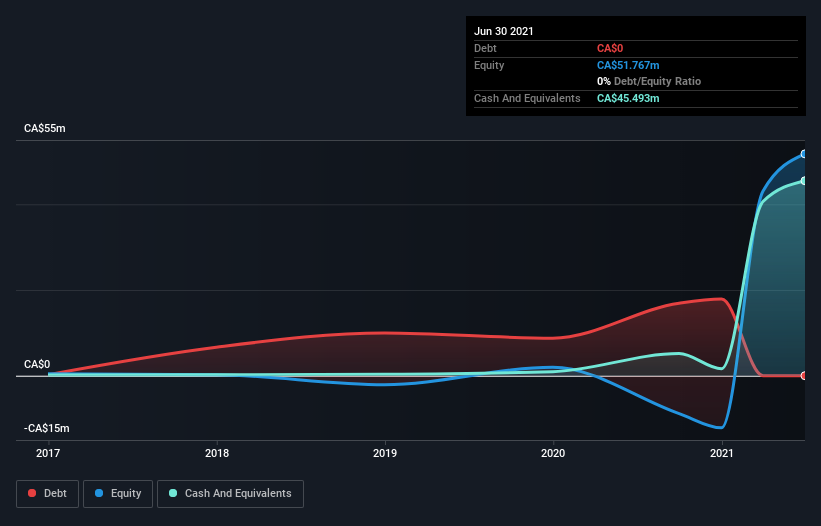- Canada
- /
- Diversified Financial
- /
- TSX:PAY
Here's Why We're Not Too Worried About Payfare's (TSE:PAY) Cash Burn Situation
We can readily understand why investors are attracted to unprofitable companies. For example, although Amazon.com made losses for many years after listing, if you had bought and held the shares since 1999, you would have made a fortune. Having said that, unprofitable companies are risky because they could potentially burn through all their cash and become distressed.
So, the natural question for Payfare (TSE:PAY) shareholders is whether they should be concerned by its rate of cash burn. For the purposes of this article, cash burn is the annual rate at which an unprofitable company spends cash to fund its growth; its negative free cash flow. The first step is to compare its cash burn with its cash reserves, to give us its 'cash runway'.
See our latest analysis for Payfare
When Might Payfare Run Out Of Money?
A company's cash runway is calculated by dividing its cash hoard by its cash burn. When Payfare last reported its balance sheet in June 2021, it had zero debt and cash worth CA$45m. In the last year, its cash burn was CA$14m. So it had a cash runway of about 3.3 years from June 2021. A runway of this length affords the company the time and space it needs to develop the business. You can see how its cash balance has changed over time in the image below.

How Well Is Payfare Growing?
Payfare actually ramped up its cash burn by a whopping 75% in the last year, which shows it is boosting investment in the business. While that certainly gives us pause for thought, we take a lot of comfort in the strong annual revenue growth of 57%. Considering the factors above, the company doesn’t fare badly when it comes to assessing how it is changing over time. While the past is always worth studying, it is the future that matters most of all. For that reason, it makes a lot of sense to take a look at our analyst forecasts for the company.
Can Payfare Raise More Cash Easily?
We are certainly impressed with the progress Payfare has made over the last year, but it is also worth considering how costly it would be if it wanted to raise more cash to fund faster growth. Generally speaking, a listed business can raise new cash through issuing shares or taking on debt. Many companies end up issuing new shares to fund future growth. By looking at a company's cash burn relative to its market capitalisation, we gain insight on how much shareholders would be diluted if the company needed to raise enough cash to cover another year's cash burn.
Since it has a market capitalisation of CA$459m, Payfare's CA$14m in cash burn equates to about 3.0% of its market value. So it could almost certainly just borrow a little to fund another year's growth, or else easily raise the cash by issuing a few shares.
How Risky Is Payfare's Cash Burn Situation?
It may already be apparent to you that we're relatively comfortable with the way Payfare is burning through its cash. For example, we think its revenue growth suggests that the company is on a good path. Although its increasing cash burn does give us reason for pause, the other metrics we discussed in this article form a positive picture overall. After taking into account the various metrics mentioned in this report, we're pretty comfortable with how the company is spending its cash, as it seems on track to meet its needs over the medium term. Taking an in-depth view of risks, we've identified 2 warning signs for Payfare that you should be aware of before investing.
Of course Payfare may not be the best stock to buy. So you may wish to see this free collection of companies boasting high return on equity, or this list of stocks that insiders are buying.
New: Manage All Your Stock Portfolios in One Place
We've created the ultimate portfolio companion for stock investors, and it's free.
• Connect an unlimited number of Portfolios and see your total in one currency
• Be alerted to new Warning Signs or Risks via email or mobile
• Track the Fair Value of your stocks
This article by Simply Wall St is general in nature. We provide commentary based on historical data and analyst forecasts only using an unbiased methodology and our articles are not intended to be financial advice. It does not constitute a recommendation to buy or sell any stock, and does not take account of your objectives, or your financial situation. We aim to bring you long-term focused analysis driven by fundamental data. Note that our analysis may not factor in the latest price-sensitive company announcements or qualitative material. Simply Wall St has no position in any stocks mentioned.
Have feedback on this article? Concerned about the content? Get in touch with us directly. Alternatively, email editorial-team (at) simplywallst.com.
About TSX:PAY
Payfare
A financial technology company, provides instant payout and digital banking solutions to gig economy workers in Canada, the United States, and Mexico.
Outstanding track record with flawless balance sheet.
Similar Companies
Market Insights
Community Narratives




